Food for thought
- Content creators are a dime a dozen
- Copywriters who are word masters are rare
- There are many types of headlines
- There are multiple headline writing methods
Headline Types
What is a headline? It’s the main message of an ad expressed in words. Why do we need headlines when we live in such a visual world? Because transit posters. IG captions. Hashtags. Dialogue in videos. The written outline of the video itself.
If you’re interested in copywriting, you need to become a master of storytelling. Of words. And of headlines.
Suzanne Pope, copywriter, creative director, editor and Professor at Humber College in Toronto, Canada, is the authority when it comes to writing headlines. I have methods I use for writing headlines for every kind of content and client. But Prof Pope put together a document called “How to Write Headlines – An Inconvenient Truth For Copywriters” – which I and many professors who teach copywriting use as a Headline Bible.

Bad headlines are easy to write. Good headlines not so much. If you want to be a copywriter, you need to know all of the different types of headlines, their unique qualities and structure. In my class, aspiring copywriters MUST write at least five different headline types. Below, you’ll find 9 types of headlines pulled directly from Prof Pope’s “How to write headlines” pdf. Click here to download the pdf which includes these types of headlines and more.
When people describe a bad toupee as a rug, or when they call a troubled celebrity a train wreck, they are speaking in metaphor. Equating your subject with something apparently unrelated helps guide your audience to a deeper and more specific understanding of that subject. People will grasp the wretchedness of a toupee much more quickly if you call it a rug than they will if you just describe it as unattractive.
Here’s a great metaphorical headline, produced by Martin/Williams, Minneapolis for L.L. Bean’s dog beds:

Another example, from Carmichael Lynch, Minneapolis for Harley-Davidson:

Headline Type 2: PERSONIFICATION
Crispin & Porter produced this wonderfully minimalist campaign for a homeless mission in Miami:
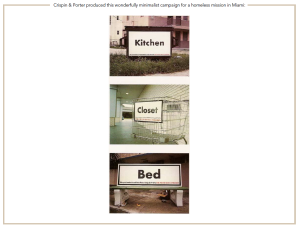
Personification is a kind of metaphor. But with personification, you’re no longer comparing your subject with an inanimate object; instead, you’re describing it as you would a human being. Personification allows you to present mere objects as being capable of love, hate, fear, hope and every other emotion available to humans.
Here’s a visually driven example, part of a great campaign done by Saatchi & Saatchi in New York for Ultra Tide:
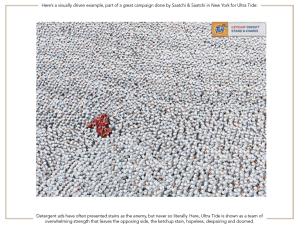
Detergent ads have often presented stains as the enemy, but never so literally. Here, Ultra Tide is shown as a team of overwhelming strength that leaves the opposing side, the ketchup stain, hopeless, despairing and doomed.
Let’s now take a look at how personification works when words play a larger role. This famous ad, from Carmichael Lynch in Minneapolis, imbued bathroom fixtures with emotion in a way that felt radically new:
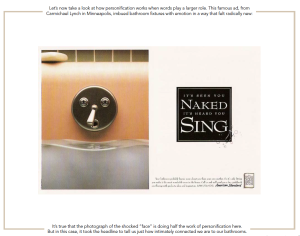
It’s true that the photograph of the shocked “face” is doing half the work of personification here. But in this case, it took the headline to tell us just how intimately connected we are to our bathrooms.
Personification is also at work in this ad for Gay Lea Spreadable Butter, done by john st. in Toronto:
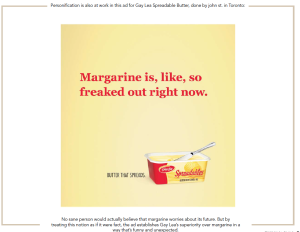
No sane person would actually believe that margarine worries about its future. But by treating this notion as if it were fact, the ad establishes Gay Lea’s superiority over margarine in a way that’s funny and unexpected.
Hyperbole is the use of outrageous exaggeration to make your point. It is well used in visual concepts, because it makes it possible to provoke shock or laughter without the need for words. You’ve already seen instances of it here: Laundry stains are hardly a life-and-death struggle, but Ultra Tide presents them as if they were. Similarly, no human being could ever be as noisy as a loudspeaker, but it helps Sony’s Noise Cancelling Headphones to depict that situation as reality.
Though hyperbole is typically viewed these days as a visual device, it can also succeed wonderfully in words alone. These two Altoids ads were produced by Leo Burnett in Chicago:

In this ad Karsh & Hagan Communications in Denver used hyperbole to arrive at a different way of telling us this knife is sharp:
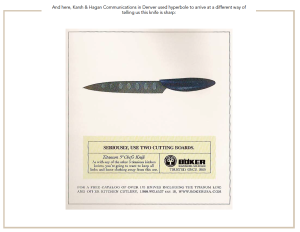
Finally, Chicago’s McConnaughy Stein Schmidt Brown sells us on the excellence of a steak house using nothing more than over-the-top words of “proof”:

Cicero defined irony as “saying one thing and meaning another.” A great example of visual irony is found in these anti-gun posters from john st. in Toronto:
Here, ordinary citizens are presented as perfectly reasonable targets for shooting practice. The intended message is, of course, completely the reverse.
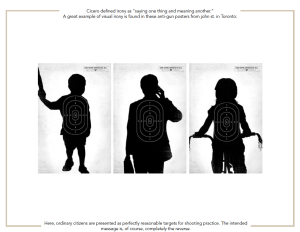
Because irony by definition involves two messages (the explicit message plus an implied one), it’s easier to achieve when you have words to help. An award-winning example, done for the American Cancer Society (by Cole Henderson Drake in Atlanta), showed a black-and-white photograph of a graveyard over the headline, “Welcome to Marlboro Country.” Similarly, the Partnership for a Drug-Free America used dead celebrities as an ironic punchline to a straight headline (Saatchi & Saatchi, New York):
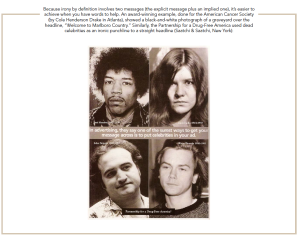
A paradox is a statement or situation that seems to be absurd or self-contradictory. The power of paradox comes from the fact that the contradiction often turns out to contain a thought-provoking grain of truth. The john st. anti-gun posters seen above provide an excellent example of visual paradox. The viewer might say, “Wait a minute…children aren’t used in target shooting” before realizing a second later that in some communities, they might as well be.
Creating paradox with your headline can result in work that has even more edge and power. Placed in a new layout, this Luke Sullivan line would probably win awards all over again (ad from The Martin Agency, Richmond):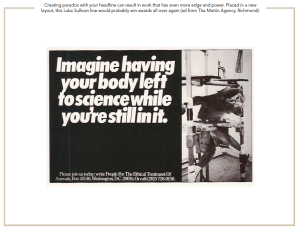
Paradox also lets you capitalize on deliciously sharp insights about your target (Fallon McElligott, agency):
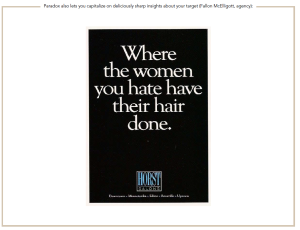
And if you’re fortunate enough to be writing about one of the world’s strongest brands, paradox allows you to speak about truths that are beyond words (Carmichael Lynch, Minneapolis, agency):

Paradox helps you hit deep emotional places. It’s also versatile enough to add power to more rational arguments (Scali, McCabe, Sloves NY)
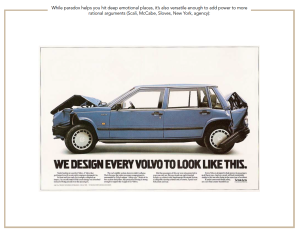
Parallelism is the deliberate repetition of a particular word, phrasing or sentence structure for effect.
Consider this ad for fishing reels, done by Core in St. Louis:
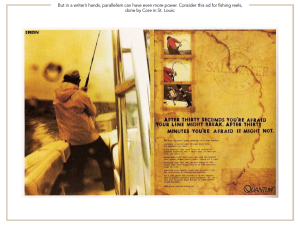
This next ad, for used Mercedes-Benz cars, uses parallelism to say something far more compelling than “affordable” (The Martin Agency, Richmond):

Parallelism is versatile enough to elevate the proposition for a humble food-storage container (agency: Pagano Schenck & Kay, Boston):
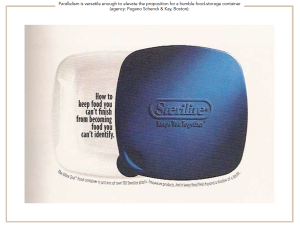
Up to now, I’ve been telling you about rhetorical devices that are as available to visual thinkers as they are to headline writers. But there are other tools that would be difficult, if not impossible, to use visually. These tools are almost exclusively the property of the writer. Not all of them will be your favorites, but I think you’ll agree that many of them have provided the foundation for some brilliant writing.
If you’re looking for edginess in your lines, anesis is a tool you’ll want to keep close at hand. It comes from the Greek word for “loosening” or “relaxing.” It is the use of a concluding sentence or phrase that undercuts or diminishes what was said previously. Typically with anesis, one starts with a fairly lofty, dignified or respectful statement and lets it all go downhill from there.
This ad from Clarke Goward, Boston, is a good example:

Borders, Perrin & Norrander used anesis to talk about a restaurant famous for its chops:
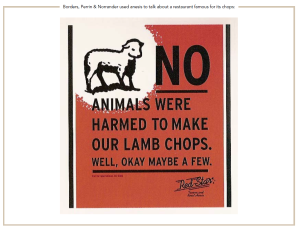
This ad for a ski resort starts with a friendly exhortation, but quickly takes a turn for the worse (agency: Clarke Goward, Boston):

In this ad for Moon Pies, Loeffler Ketchum Mountjoy of Charlotte, NC makes fun of the language of nutritional claims:
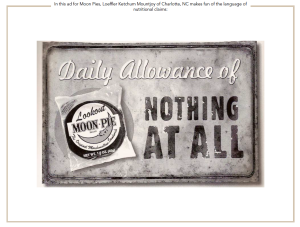
We’ve already seen how much metaphor gets used in visual advertising. When the equation of a metaphor (“life is a poker game”) is altered by adding the word “like” or “as” (“life is like a poker game”) the resulting comparison is known as a simile. Simile gives you a subtler way to provoke mental images, a way that is not available to strictly visual thinkers.


Agencies: Fallon McElligott, Minneapolis and BVK/McDonald, Milwaukee, respectively.
This is a question to which no answer is needed or expected. It is asked to bring your listener or reader to your chosen conclusion. When you mention something ridiculous and ask your friend, “How stupid is that?” you are asking a rhetorical question.
Rhetorical questions are powerful tools, tools that don’t exist in all-visual advertising. They can be used in an emotional appeal (Earle Palmer Brown, Bethesda, agency):
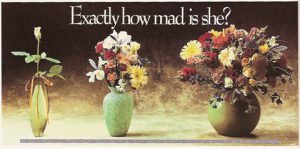
Rhetorical questions are flexible enough to advance even a deliberately nonsensical argument (TBWA/Chiat/Day, Los Angeles, agency):
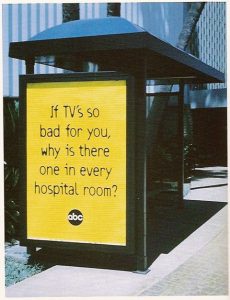
How to Write Headlines
So now you know there are dozens of types of headlines which you can write. But how do you get started writing them? Start with a writing prompt. A writing prompt is a sentence or question that “greases the wheel” of your writer’s imagination. Specifically for this class, the message of your Creative Strategy Statement/Campaign Proposal is your writing prompt.
That message is what you need to say to your consumer. The way you say it is copywriting. In other words, the CSS/CP message is the “Say it straight”. The headline is the “Say it great”. Here’s an example.
Headline Writing Example – Just For Men 8 Weeks of Sexy
- First, Say it Straight
- Then, Say it Great
In the JFM 8 Weeks of Sexy campaign, the main message is:
Get eight weeks of dates and get the girl.
This is the message you want your consumer to take away from your campaign. It’s the Say it Straight. Let’s use this as our writing prompt – as our “Say it Great” to help us come up with 4 different types of headlines.
Rhetorical headline
How long will it take Mr. So So meet Ms. Right?
Parallelism headline
After 8 dates, you’ll know you’ve only just begun. After 8 weeks, you’ll know the happy ending is near.
Ironic headline
Maybe the problem isn’t the women you’re meeting but the man they’re meeting.
Personification headline
It’s OK to forget to thank it in your wedding speech.
Headline Writing Example – AI Writing Tool
- First, create a writing prompt
- Second, give the prompt to the AI Writing Tool
- Third, use what AI comes up with assist you in creating human-written headlines
AI writing tools are controversial – for good reason. This Forbes article titled 14 Benefits and Drawbacks of Using AI Tools to Write Business Content, states: “…the use of AI tools to generate content has sparked a heated debate in recent times. Advocates argue these tools offer numerous benefits, such as increased efficiency, improved productivity and cost savings. On the other hand, critics express concerns about the potential drawbacks, including the loss of human creativity, ethical issues and the risk of bias.”
The biggest concern copywriters have is that AI will replace us. But as Brian David Crane says “What is hard to present when writing is not data but the human emotional connection that readers gravitate to, and personalization, which AI cannot duplicate. This is why human-written content will always win!”
The value of AI writing tools in a copywriting class is they can assist you by offering many headline options in a short period of time. Notice I use the word “assist”. Because you shouldn’t expect them to generate flawlessly brilliant headlines. After all, they’re missing that touch of humanity only you can provide.
As you can see below, I used keywords from the JFM 8 weeks of sexy campaign message to generate 7 headlines in about 10 minutes using the Kickass Headline Generator. The next thing I would do would be to use the S.T.A.R. method to Substitute, Take out, Add, and Rearrange words until I ended up with a few headlines that seemed worthy of the concept. But I wouldn’t stop there. I’d use another AI headline generator to assist me in coming up with headlines of a different type – ironic, paradoxical, or hyperbolic headlines.
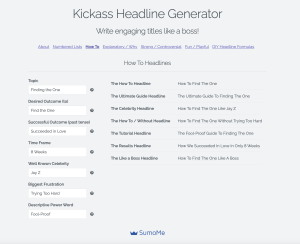
NOTE: This is just one of the many headline generators available.
Write Headlines Fast Example – Shlomo Genchin
- Find an enemy
- Gather intelligence
- Mind map
- Find phrases
- Connect facts + phrases = headlines
Shlomo Genchin is a copywriter, Creative Director. He’s currently Head of Creative at Ground Up Ventures where he uses creative marketing to help dozens of founders grow their early-stage startups and personal brands. He’s also founder of The Creative Marketer, where he’s building an impressive collection of Techniques & tools for copywriters, marketers, and other creative creatures.


Key Takeaways
- Copywriters must be good at writing headlines
- There are dozens of types of headlines
- The more headlines you write, the more options you have to choose from
- There are many methods to help you write headlines, including writing prompts, the S.T.A.R. method, AI writing tools and more
Next up: Taglines.
